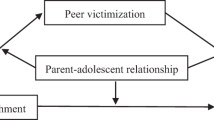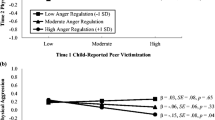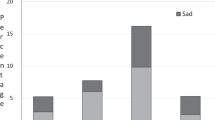Abstract
This study aimed to examine a multi-mediator model explaining how exposure to parent-child physical aggression may link with adolescents’ peer-directed physical aggression and their own subjective happiness, in an understudied Israeli Arab population. Mediators included hostility, anger, need to belong, and self-control. Arab adolescents from northern Israel (N = 155; 62 % girls, aged 16-17) completed questionnaires regarding parents’ physical violence toward them, their own aggression toward peers, need to belong, happiness, positive emotions, and selfcontrol skills. (a) Parent-child physical aggression linked positively with peerdirected aggression through the mediating associations of hostility with anger; (b) parent-child physical aggression linked negatively with peer-directed aggression and happiness through the mediation of adolescents’ increased need to belong; and (c) parent-child physical aggression was not directly linked with self-control, but selfcontrol directly linked negatively with peer-directed aggression and positively with happiness. Findings highlight pathways through which parent-child physical aggression may simultaneously influence adolescents’ aggressive behavior and happiness. The mediation detected possible process variables (e.g., yearning for belonging, self-control skills, hostile thoughts, and angry feelings) that researchers and clinicians can consider in designing prevention and treatment interventions to break the inter-generational cycle of violence.

Similar content being viewed by others
References
Agbaria, Q., Ronen, T., & Hamama, L. (2012). The link between developmental components (age and gender), need to belong, and resources of self-control and feelings of happiness, and frequency of symptoms among Arab adolescents in Israel. Children and Youth Services Review, 34(10), 2018–2027.
Anderson, C. A., & Bushman, B. (2002). Human aggression. Annual Review of Psychology, 53, 27–51.
Arsenio, W. F., Cooperman, S., & Lover, A. (2000). Affective predictors of preschoolers’ aggression and peer acceptance: direct and indirect effects. Developmental Psychology, 36, 438–448.
Baumeister, R. F., & Leary, M. R. (1995). The need to belong: desire for interpersonal attachments as a fundamental human motivation. Psychological Bulletin, 117, 497–529.
Ben-Arieh, A., & Haj-Yahia, M. (2006). The “geography” of child maltreatment in Israel: findings from a national data set of cases reported to the social services. Child Abuse & Neglect, 30(9), 991–1003.
Bergeron, N., & Schneider, B. H. (2005). Explaining cross-national differences in peer- directed aggression: a quantitative synthesis. Aggressive Behavior, 31(2), 116–137.
Bowlby, J. (1973). Attachment and Loss: Vol 2. Separation. New York: Basic Books.
Buss, A. H. (1961). The psychology of aggression. New York: John Wiley.
Buss, A. H., & Perry, M. (1992). The aggression questionnaire. Journal of Personality and Social Psychology, 63(3), 452–459.
Byrne, B. M. (2010). Structural equation modeling with AMOS: Basic concepts, applications, and programming (2nd ed.). New York: Routledge.
Carr, A. (2004). Positive psychology: The science of happiness and human strength. New York: Hove & Brunner-Routledge.
Carvallo, M., & Pelham, B. W. (2006). When fiends become friends: the need to belong and perceptions of personal and group discrimination. Journal of Personality and Social Psychology, 90, 94–108.
Cha, E. S., Kim, K. H., & Erlen, J. A. (2007). Translation of scales in cross-cultural research: Issues and techniques. Journal of Advanced Nursing, 58, 386–395.
Davies, D. (1999). Child development: A practitioner’s guide. New York: Guilford Press.
De Zoysa, P. (2006). Parental use of physical force towards school children in the Colombo district: Prevalence, psychosocial correlates and psychological consequences (Unpublished doctoral dissertation). University of Colombo, Sri Lanka.
Diener, E. (2009). The science of subjective well-being: The collected works of Ed Diener. Social Indicators Research Series: Vol. 37. New York: Springer.
Dodge, K. A., Pettit, G. S., Bates, J. E., & Valente, E. (1995). Social information-processing patterns partially mediate the effect of early physical abuse on later conduct problems. Journal of Abnormal Psychology, 104, 632–643.
Dodge, K. A., Coie, J. D., & Lynam, D. (2006). Aggression and antisocial behavior in youth. In N. Eisenberg (Ed.), Handbook of child psychology (Vol. 3, pp. 719–788). NJ: John Wiley.
Dorfman-Zukerman, R. A., Meyer, P., & Morgan, D. M. (2004). Paradigms of clinical social work: Emphasis on diversity. New York: Burrner-Routledge.
Downey, G., Lebolt, A., Rincon, C., & Freitas, A. L. (1998). Rejection sensitivity and children’s interpersonal difficulties. Child Development, 69, 1074–1091.
Downey, G., Feldman, S., & Ayduk, O. (2000). Rejection sensitivity and male violence in romantic relationships. Personal Relationship, 7, 45–61.
Dumont, M., & Provost, M. A. (1999). Resilience in adolescence: protective role of social support, coping strategies, self-esteem, and social activities on experience of stress and depression. Journal of Youth and Adolescence, 28, 343–363.
Dwairy, M., Achoui, M., Abouserie, R., Farah, A., Sakhleh, A. A., Fayad, M., & Khan, H. K. (2006). Parenting styles in Arab societies: a first cross-regional research study. Journal of Cross-Cultural Psychology, 37(3), 230–247. doi:10.1177/0022022106286922.
Elbedour, S., Abu-Bader, S., Onwuegbuzie, A., Abu-Rabia, A., & El-Aassam, S. (2006). The scope of sexual, physical, and psychological abuse in a Bedouin-Arab community of female adolescents: the interplay of racism, urbanization, polygamy, family honor, and the social marginalization of women. Child Abuse & Neglect, 30, 215–229.
Espelage, D. L., Low, S., Rao, M. A., Hong, J. S., & Little, T. D. (2014). Family violence, bullying, fighting, and substance use among adolescents: a longitudinal mediational model. Journal of Research on Adolescence, 24(2), 337–349.
Frazier, P. A., Tix, A. P., & Barron, K. E. (2004). Testing moderator and mediator effects in counseling psychology research. Journal of Counseling Psychology, 51, 115–134. doi:10.1037/0022-0167.51.1.115.
Fredrickson, B. (2009). Positivity: Groundbreaking research reveals how to embrace the hidden strength of positive emotions, overcome negativity, and thrive. New York: Crown.
Futa, K. T., Nash, C. L., Hansen, D. J., & Garbin, C. P. (2003). Adult survivors of childhood abuse: an analysis of coping mechanisms used for stressful childhood memories and current stressors. Journal of Family Violence, 18, 227–239.
Gable, S. L., & Haidt, J. (2005). What (and why) is positive psychology? Review of General Psychology, 9, 103–110.
Gallaher, T., Seiffge-Krenke, I., Borge, A., Cicognani, E., Cunha, M., Loncaric, D.,… Winkler-Metzke, C. (2007). Adolescent coping with everyday stressors: A seven-nation study of youth from central, eastern, southern and northern Europe. European Journal of Developmental Psychology, 4, 129–156.
Gilbert, D. (2005). Stumbling on happiness. New York: Vintage Books.
Graham-Bermann, S. A. (2002). Child abuse in the context of domestic violence. In J. E. B. Myers, L. Berliner, J. Briere, C. T. Hendrix, C. Jenny, & T. A. Reid (Eds.), The APSAC handbook on child maltreatment (2nd ed., pp. 119–129). Thousand Oaks: Sage.
Graham-Bermann, S. A., Howell, K. H., Miller, L. E., Kwek, J., & Mocje, M. L. (2010). Traumatic events and maternal education as predictors of verbal ability for preschool children exposed to intimate partner violence (IPV). Journal of Family Violence, 25, 383–392.
Haj-Yahia, M. M. (1995). Toward culturally sensitive intervention with Arab families in Israel. Contemporary Family Therapy, 17, 429–447.
Haj-Yahia, M. M., & Abdo-Kaloti, R. (2003). The rates and correlates of the exposure of Palestinian adolescents to family violence: toward an interactive-holistic approach. Child Abuse and Neglect, 27(7), 781–799.
Haj-Yahia, M. M., & Ben-Arieh, A. (2000). The incidence of Arab adolescents’ exposure to violence in their families of origin and its sociodemographic correlates. Child Abuse & Neglect, 10, 1299–1315.
Haj-Yahia, M., & Clark, C. (2013). Intimate partner violence in the occupied Palestinian territory: prevalence and risk factors. Journal of Family Violence, 28(8), 797–809. doi:10.1007/s10896-013-9549-2.
Haj-Yahia, M. M., Musleh, K., & Haj-Yahia, Y. M. (2002). The incidence of adolescent maltreatment in Arab society and some of its psychological consequences. Journal of Family Issues, 23(8), 1032–1064.
Hamama, L., & Ronen-Shenhav, A. (2012). Self-control, social support, and aggression among adolescents in divorced and two-parent families. Children and Youth Services Review, 34(5), 1042–1049. doi:10.1016/j.childyouth.2012.02.009.
Helsen, M., Volleberg, W., & Meeus, W. (2000). Social support from parents and friends and emotional problems in adolescence. Journal of Youth and Adolescence, 29, 319–335. doi:10.1023/A:1005147708827.
Hirschi, T., & Gottfredson, M. R. (2001). Self-control theory. In R. Paternoster & R. Bachman (Eds.), Explaining criminals and crime: Essays in contemporary criminological theory (pp. 81–96). Los Angeles: Roxbury.
Joireman, J., Anderson, J., & Strathman, A. (2003). The aggression paradox: understanding links among aggression, sensation seeking and the consideration of future consequences. Journal of Personality and Social Psychology, 84, 1287–1302.
Jouriles, E. N., McDonald, R., & Norwood, W. D. (2001). Issues and controversies in documenting the prevalence of children’s exposure to domestic violence. In S. A. Graham-Bermann & J. L. Edleson (Eds.), Domestic violence in the lives of children: The future of research, intervention, and social policy (pp. 12–34). Washington, DC: American Psychological Association. doi:10.1037/10408-002.
Jouriles, E. N., McDonald, R., Smith Slep, A. M., Heyman, R. E., & Garrido, E. (2008). Child abuse in the context of domestic violence: prevalence, explanations, and practice implications. Violence and Victims, 23(2), 221–235. doi:10.1891/0886-6708.23.2.221.
Jouriles, E. N., Vu, N. L., McDonald, R., & Rosenfield, D. (2014). Children’s appraisals of conflict, beliefs about aggression and externalizing problems in families characterized by severe intimate partner violence. Journal of Family Psychology, 28(6), 915–924. doi:10.1037/a0037921.
Kazdin, A. E., & Weisz, J. R. (Eds.). (2010). Evidence-based psychotherapies for children and adolescents (2nd ed.). New York: Guilford.
Kelly, K. M. (1999). Measurement and manifestation of the need to belong (Unpublished doctoral dissertation). University of Tennessee, Knoxville.
Keyes, C. L. (2006). Subjective well-being in mental health and human development research worldwide: an introduction. Social Indicators Research, 77, 1–10.
Keyes, C. L., Wissing, M., Potgieter, J. P., Temane, M., Kruger, A., & van Rooy, S. (2008). Evaluation of the mental health continuum–short form (MHC– SF) in Setswana-speaking South Africans. Clinical Psychology and Psychotherapy, 15, 181–192.
Khoury-Kassabri, M., Astor, R. A., & Benbenishty, R. (2009). Middle Eastern adolescents’ perpetration of school violence against peers and teachers: a cross-cultural and ecological analysis. Journal of Interpersonal Violence, 24, 159–182.
Laurent, J., Catanzaro, S. J., Rudolph, K. D., Joiner, T. E., Potter, K. I., Lambert, S., Osborne, L., & Gathright, T. (1999). A measure of positive and negative affect for children: scale development and preliminary validation. Psychological Assessment, 11, 326–338.
Leary, M. R., Kelly, K. M., & Schreindorfer, L. S. (2001). Individual differences in the “need to belong.” Unpublished manuscript, Wake Forest University, Winston-Salem, NC.
Leary, M. R., Kelly, K. M., Cotrell, C. A., & Schreindorfer, L. S. (2013). Construct validity of the need to belong scale: mapping the nomological network. Journal of Personality Assessment, 95, 610–624. doi:10.1080/00223891.2013.819511.
Luchies, L. B., Finkel, E. J., & Fitzsimons, G. M. (2011). The effects of self-regulatory strength, content, and strategies on close relationships. Journal of Personality, 79(6), 1251–1280.
Lyubomirsky, S. (2007). The how of happiness. London: Sphere.
Lyubomirsky, S., & Lepper, H. S. (1999). A measure of subjective happiness: preliminary reliability and construct validation. Social Indicators Research, 46, 137–155.
Lyubomirsky, S., King, L. A., & Diener, E. (2005). The benefits of frequent positive affect: does happiness lead to success? Psychological Bulletin, 131, 803–855.
Magyar-Moe, J. L. (2009). Therapist’s guide to positive psychological interventions. New York: Elsevier Academic Press.
Mahoney, A., Donnelly, W. O., Boxer, P., & Lewis, T. (2003). Marital and severe parent-to-adolescent physical aggression in clinic-referred families: co-occurrence and links to child behavior problems. Journal of Family Psychology, 17, 3–19.
Margolin, G., & Gordis, E. B. (2000). The effects of family and community violence on children. Annual Review of Psychology-Annual Reviews, 51, 445–479.
Margolin, G., & Gordis, E. B. (2003). Co-occurrence between marital aggression and parents’ child abuse potential: the impact of cumulative stress. Violence and Victims, 18, 243–258.
Mathis, G., Mueller, C. W., Zhang, Y., & Becker, K. D. (2010). Children’s exposure to violence by various family members living in the home. Journal of Child & Adolescent Trauma, 3, 1–12.
Milaniak, I., & Widom, C. S. (2014). Does child abuse and neglect increase risk for perpetration of violence inside and outside the home? Psychology of Violence. Advance online publication. doi:10.1037/a0037956
Mohr, W. K., Lutz, M. J., Fantuzzo, J. W., & Perry, M. A. (2000). Children exposed to family violence: a review of empirical research from a developmental-ecological perspective. Trauma, Violence & Abuse, 1(3), 264–283.
Orkibi, H., Ronen, T., & Assoulin, N. (2014). The subjective well-being of Israeli adolescents attending specialized school classes. Journal of Educational Psychology, 106(2), 515–526. doi:10.1037/a0035428.
Orkibi, H., Hamama, L., Gavriel-Fried, B., & Ronen, T. (2015). Pathways to adolescents’ flourishing: Linking self-control skills and positivity ratio through social support. Youth & Society. Advance online publication. doi:10.1177/0044118x15581171
Orpinas, P., & Horne, A. M. (2006). Bullying prevention: Creating a positive school climate and developing social competence. Washington, DC: American Psychological Association.
Osofsky, J. D. (2003). Prevalence of children’s exposure to domestic violence and child maltreatment: implications for prevention and intervention. Clinical Child and Family Psychology Review, 6, 161–170.
Ozden, O., & Koksoy, O. (2009). Is low self-control associated with violence among youth in Turkey? International Journal of Offender Therapy and Comparative Criminology, 53, 145–167.
Pickett, C. L., Gardner, W. L., & Knowles, M. (2004). Getting a cue: the need to belong and enhanced sensitivity to social cues. Personality and Social Psychology Bulletin, 30, 1095–1107.
Preacher, K., & Hayes, A. (2004). SPSS and SAS procedures for estimating indirect effects in simple mediation models. Behavior Research Methods, Instruments, & Computers, 36(4), 717–731. doi:10.3758/bf03206553.
Ronen, T., & Rosenbaum, M. (2001). Helping children to help themselves: a case study of enuresis and nail biting. Research on Social Work Practice, 11(3), 338–356.
Ronen, T., & Rosenbaum, M. (2010). Developing learned resourcefulness in adolescents to help them reduce their aggressive behavior: preliminary findings. Research on Social Work Practice, 20(4), 410–426. doi:10.1177/1049731509331875.
Ronen, T., & Seeman, A. (2007). Subjective well-being of adolescents in boarding schools under threat of war. Journal of Traumatic Stress, 20, 1053–1062.
Ronen, T., Abuelaish, I., Rosenbaum, M., Agbaria, Q., & Hamama, L. (2013). Predictors of aggression among Palestinians in Israel and Gaza: Happiness, need to belong, and self- control. Children and Youth Services Review, 35(1), 47–55.
Ronen, T., Hamama, L., Rosenbaum, M., & Mishcaly-Yarlp, E. (2014). Subjective well-being in adolescence: the role of self-control, social support, age, gender, and familial crisis. Journal of Happiness Studies. doi:10.1007/s10902-014-9585-5.
Rosenbaum, M. (1980). A schedule for assessing self-control behavior: preliminary findings. Behavior Therapy, 11, 109–121.
Rosenbaum, M. (1990). The role of learned resourcefulness in self-control of health behavior. In M. Rosenbaum (Ed.), Learned resourcefulness: On coping skills, self-control and adaptive behavior (pp. 3–30). New York: Springer.
Rosenbaum, M. (1998). Learned resourcefulness, stress, and self-regulation. In S. Fisher & J. Reason (Eds.), Handbook of life stress, cognition and health (pp. 483–496). Chichester: Wiley.
Rosenbaum, M. (2000). The self-regulation of experience: Openness and construction. In P. Dewe, A. M. Leiter, & T. Cox (Eds.), Coping and health and organizations (pp. 51–67). London: Taylor & Francis.
Rosenbaum, M., & Ronen, T. (1991). Development of a rating scale for assessment of children’s self-control skills (CSC). Paper presented at the Annual Meeting of the Association for the Advancement of Behavior Therapy, New York, NY.
Rosenbaum, M., Ronen, T., Abuelaish, I., & Agbaria, Q. (2015). Adolescents’ aggression as a function of political violence, cultural values, self-control skills, and emotional well-being: Comparisons between Israeli Jews, Israeli Palestinians, and Gazan Palestinians. Manuscript submitted for publication.
Sagy, S., Orr, E., Bar-On, D., & Awwad, E. (2001). Individualism and collectivism in two conflicted societies. Youth & Society, 33, 3–30.
Schreiber, J. B., Nora, A., Stage, F. K., Barlow, E. A., & King, J. (2006). Reporting structural equation modeling and confirmatory factor analysis results: a review. Journal of Educational Research, 99(6), 323–338.
Simonelli, C. J., Mullis, T., & Rohde, C. (2005). Scale of negative family interactions: a measure of parental and sibling aggression. Journal of Interpersonal Violence, 20(7), 792–803.
Steinberg, L. (2005). Cognitive and affective development in adolescence. Trends in Cognitive Science, 9, 69–74. doi:10.1016/j.tics.2004.12.005.
Steinberg, L. (2007). Adolescence (8th ed.). New York: McGraw-Hill.
Steinberg, L., & Morris, A. S. (2001). Adolescent development. Journal of Cognitive Education and Psychology, 2(1), 55–87.
Straus, M. A., Hamby, S. L., Finkelhor, D., Moore, D. W., & Runyan, D. (1998). Identification of child maltreatment with the Parent–child Conflict Tactics Scales: development and psychometric data for a national sample of American parents. Child Abuse & Neglect, 22(4), 249–270. doi:10.1016/S0145-2134(97)00174-9.
Tangney, J. P., Baumeister, R. F., & Boone, A. L. (2004). High self-control predicts good adjustment, less pathology, better grades, and interpersonal success. Journal of Personality, 72, 271–322.
Taylor, A. B., McKinnon, D. P., & Tein, J.-Y. (2008). Tests of the three-path mediated effect. Organizational Research Methods, 11, 214–269.
Vasta, R., Haith, M. M., & Miller, S. A. (1995). Child psychology: The modern science. New York: Wiley.
Voisin, D. R., & Hong, J. S. (2012). A conceptual formulation examining the relationship between witnessing domestic violence and bullying behaviors and victimization among youth. Educational Psychology Review, 24(4), 479–498.
Walters, G. D., Ronen, T., & Rosenbaum, M. (2010). The latent structure of childhood aggression: a taxometric analysis of self-reported and teacher-rated aggression in Israeli schoolchildren. Psychological Assessment, 22(3), 628–637.
Watson, D., Clark, L., & Tellegen, A. (1998). Development and validation of brief measures of positive and negative affect: the PANAS Scales. Journal of Personality and Social Psychology, 54, 1063–1070.
Weisbrod, N., Rosenbaum, M., & Ronen, T. (2009). Sensitivity to rejection and aggression among young female and male adolescents. Society and Welfare, 29(1), 107–131 (in Hebrew).
Whitaker, B. (2009). What’s really wrong with the Middle East? London: Saqi Books.
Acknowledgments
We are thankful to Yasmin Alkalay for her statistical consultation and to Dee B. Ankonina for her editorial consultation.
Author information
Authors and Affiliations
Corresponding author
Additional information
Qutaiba Agbaria, Liat Hamama, Hod Orkibi, Belle Gabriel-Fried and Tammie Ronen contributed equally to this work.
Rights and permissions
About this article
Cite this article
Agbaria, Q., Hamama, L., Orkibi, H. et al. Multiple Mediators for Peer-Directed Aggression and Happiness in Arab Adolescents Exposed to Parent–child Aggression. Child Ind Res 9, 785–803 (2016). https://doi.org/10.1007/s12187-015-9346-y
Accepted:
Published:
Issue Date:
DOI: https://doi.org/10.1007/s12187-015-9346-y




